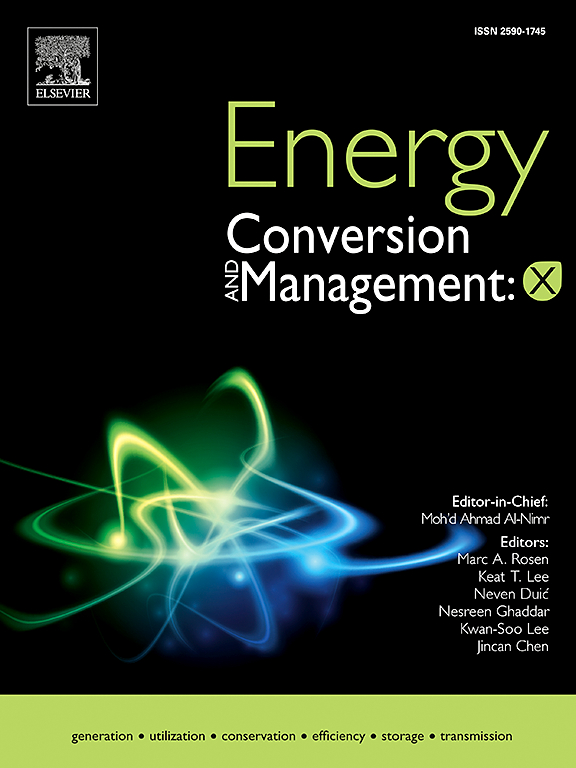Experimental analysis of copper foam thicknesses and non-uniform configurations on the performance of direct absorption parabolic trough collectors
IF 7.6
Q1 ENERGY & FUELS
引用次数: 0
Abstract
Enhancing the thermal efficiency of direct absorption parabolic trough collectors is a fundamental challenge in advancing solar energy technologies, as improved heat absorption directly impacts overall system performance. This study experimentally investigates the influence of copper porous foams on the thermal performance of a direct absorption parabolic trough collector, aiming to optimize efficiency by analyzing various porous foam configurations under varying inlet temperatures (20 °C, 30 °C, and 40 °C) and flow rates (20–120 Lph). Four foam thicknesses, representing 25 %, 50 %, 75 %, and 100 % of the absorber tube’s inner radius, were tested in full and semi-porous arrangements. Additionally, two innovative gradient foams with radially variable pore densities—one increasing and one decreasing—were developed and analyzed. The results indicated that increasing foam thickness enhanced thermal efficiency, with maximum improvements of 111.6 %, 125.5 %, 133.9 %, and 143.9 % for the 25 %, 50 %, 75 %, and 100 % configurations, respectively. The full-porous 100 % foam achieved the highest thermal efficiency of 51.3 % (at 20 °C, 120 Lph) and a maximum temperature difference of 15.3 °C (at 20 Lph), albeit with the highest friction factor. The semi-porous arrangement yielded maximum efficiencies of 37.6 % and 44.8 % for 25 % and 100 % foams, respectively. The performance evaluation criteria for the 25 % copper foam in both full and semi-porous arrangements exceeded one, reaching a peak of 1.42, indicating it as the optimal configuration. Notably, the gradient copper foam with radially increasing pore density achieved a thermal efficiency of 50.3 %, comparable to the full-porous 100 % foam, but with reduced pressure drop, resulting in superior performance evaluation criteria.
泡沫铜厚度和非均匀结构对直接吸收抛物面槽集热器性能的实验分析
提高直接吸收抛物面槽集热器的热效率是推进太阳能技术的一个基本挑战,因为提高热吸收直接影响整个系统的性能。本研究通过分析不同入口温度(20°C、30°C和40°C)和流速(20 - 120 Lph)下不同多孔泡沫结构对直接吸收抛物线槽集热器热性能的影响,以优化其效率。在全孔和半孔布置下测试了四种泡沫厚度,分别占吸收管内半径的25%、50%、75%和100%。此外,还开发和分析了两种具有径向可变孔隙密度的创新型梯度泡沫——一种增大,一种减小。结果表明,增加泡沫厚度可提高热效率,25%、50%、75%和100%配置的热效率分别提高111.6%、125.5%、133.9%和143.9%。尽管具有最高的摩擦系数,但全孔100%泡沫的热效率最高,达到51.3%(20℃,120 Lph),最大温差为15.3℃(20 Lph)。对于25%泡沫和100%泡沫,半多孔结构的效率分别为37.6%和44.8%。25%泡沫铜在全孔和半孔布置下的性能评价指标均超过1,达到峰值1.42,为最优配置。值得注意的是,随着孔隙密度呈径向增加,梯度泡沫铜的热效率达到50.3%,与全孔100%泡沫相当,但压降较小,因此具有更高的性能评价标准。
本文章由计算机程序翻译,如有差异,请以英文原文为准。
求助全文
约1分钟内获得全文
求助全文
来源期刊

Energy Conversion and Management-X
Multiple-
CiteScore
8.80
自引率
3.20%
发文量
180
审稿时长
58 days
期刊介绍:
Energy Conversion and Management: X is the open access extension of the reputable journal Energy Conversion and Management, serving as a platform for interdisciplinary research on a wide array of critical energy subjects. The journal is dedicated to publishing original contributions and in-depth technical review articles that present groundbreaking research on topics spanning energy generation, utilization, conversion, storage, transmission, conservation, management, and sustainability.
The scope of Energy Conversion and Management: X encompasses various forms of energy, including mechanical, thermal, nuclear, chemical, electromagnetic, magnetic, and electric energy. It addresses all known energy resources, highlighting both conventional sources like fossil fuels and nuclear power, as well as renewable resources such as solar, biomass, hydro, wind, geothermal, and ocean energy.
 求助内容:
求助内容: 应助结果提醒方式:
应助结果提醒方式:


